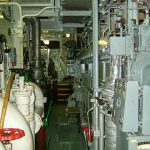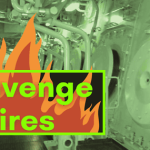The ship’s engine room watch-keeping engineer must be familiar with main engine layouts, including their components optimum operating pressures and temperatures. This familiarization should include a B&W engine room layout, as this is a modern, popular two stroke marine diesel engine.
The arrangement of a large two/four stroke marine diesel has not changed dramatically since I was at sea over forty years ago. The main engines then were Sulzer RD’s, Doxfords opposed piston, British Polar and Burmeister & Wain (I served my time in Harland & Wolff Belfast, who made B&W engines under license)
The main difference in layout is that most engine rooms now have a soundproof, air conditioned control room and are accessed by a lift from the engineer’s accommodation. Nowadays ships watchkeeping engineers don’t know they are living, we had to endure excessive temperatures and noise, but I still remain convinced, whilst open to the engine room environment we had a better feel for the job.
The next few sections examine the layout of a modern oil tanker engine room beginning with the main engine and major components; using a Burmeister & Wain two-stroke turbo charged diesel engine with the aid of sketches as an example. A sketch is provided referencing the components with their function and, where applicable the watch-keeping engineer’s duties in maintaining their optimum operating conditions.
Layout off Major Components
Fuel oil nozzle cooler
Nozzles are under constant heat from combustion, so in order for them to atomize the fuel efficiently, they must be kept relatively cool, and failure to do so can lead to scavenge fires. The nozzles are kept cool by circulating water through them, in a closed circuit cooling system that includes the nozzle cooler and circ pump. The watch-keeper should check the cooler inlet and outlet temperatures hourly.
Air-Start Valve
The air start valve is used to starting the engine by compressed air. Watch-keeper should check that there is no back flow of combustion gas through air start supply pipework. This is easily done by feeling the air supply pipework by placing a hand on it. Always check air supply isolating valves from the air start bottles are shut, unless on standby.
Air Start Reservoir and Air Compressor
This is the main reservoir for holding the air used to start the engine. The air compressor is used to maintain the correct pressure. Watch-keeper should check air pressure hourly, topping up at the end of each watch, also drain water and oil mixture from vessel through drain valve at bottom of vessel. Excessive oil in this mixture indicates a faulty air compressor.
Crankcase Door Explosion Relief Valve
If a crankshaft bearing is running hot, oil is heated and an oil mist produced which can lead to a crankcase explosion. The crankcase door explosion relief valve is fitted so that if there is an internal explosion, the relief valve operates and the pressure inside is relieved. If this didn’t work, the pressure from the explosion would blow the door of its hinges. (This happened to a ship called the Reina Del Pacifico in 1947, after an extensive engine overhaul and whilst it was on sea-trials in Belfast Lough, there was a crankcase explosion and twenty eight men were killed.) Watch-keepers duties are to lay a hand on crankcase doors and around the relief valve to check for excessive heat, every time they are passing the doors. This will soon become a habit.
Lube-oil Pump, Cooler and Filters
This is probably the most important system on a marine diesel engine. Oil is drawn from the sump through the filters and pumped through the coolers onto the crossheads, main bearings and camshafts. Watch-keepers duties are to ensure optimum temperature and pressure (thereby viscosity) is maintained by using lube-oil cooler seawater inlet valve. Regular checks of sump oil (dip sump to check level and oil condition) for water ingress is necessary along with filter differential pressure checks to ensure filter efficiency, any pressure out with norm signifies filter change required.
Jacket Cooling System.
The cylinders are cooled by circulating a coolant made up of a mixture of fresh water and soluble oil (much like the coolant used in lathes) around the cylinder jackets. The watch-keeping duties are to control the temperature of the coolant by using the jacket water cooler seawater inlet valve.
Turbo-Blowers
The turbo blowers have two turbines on the same drive shaft. The exhaust gas from the poppet valve enters the drive turbine end rotating it at about 10,000-15,000 revs. This drives the air compressor turbine at the other end of the shaft that draws in air from the engine room, blows it through an air cooler before supplying the combustion air to the engine via the scavenge ports in the cylinders. Because the blowers continue to rotate when the engine stops, the lube-oil supply is normally from a header tank or from the main engine lube-oil system.
Turbo-Blower Cooler
Air is essential to the combustion process however air expands when it is hot and contracts when cold. Because of this the hot air which is sucked in, compressed and discharged by the turbo becomes even hotter must be cooled. This is carried out by an air cooler located between the turbo discharge and inlet to scavenge ports, thus ensuring that the maximum amount of air is supplied for combustion of the fuel. When the engine is in the maneuvering condition, or running slowly an electrically driven blower is used to supply combustion air to the engine. The temperature before and after air cooler should be checked.
Cylinder Head Relief Valve
The function of a cylinder relief valve is to release overpressure from the combustion area above the piston, for instance if there is an accumulation of water which is incompressible, the valve will lift. Watch-keeping duties are to ensure no hot gasses escape from the relief valve by checking connecting pipework by hand for excessive heat.
Indicator Cock
There several purposes of this cock. An engine indicator is used to calculate the indicated power of the engine, and this is connected to the indicator cock and the cock opened. The engine indicator is operated as the engine fires when running normally, the cock being shut before disconnecting the engine indicator.
The indicator cock is opened when the engine is being turned over by the turning gear and, when being started for the first time after being shutdown to blow out any water or debris from the cylinder. The cock is then shut for normal running. Watch-keeping duties include checking the cock is not leaking exhaust gas, if it is a temporary cap can be screwed on, and the cock replaced at the first opportunity at next shutdown.
A sketch that should be read in conjunction with these notes is shown below;



